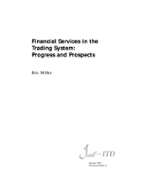Financial Services in the Trading System: Progress and Prospects
Date
Jan 1999
EDITOR
INTAL
In the winter of 1996, Canada's third largest financial institution, the Bank of Montreal, launched a now infamous advertising campaign in which it asked the question: Can a bank change? While the resulting ads naturally responded in the affirmative, many other large financial institutions were asking themselves the same question. The dramatic acceleration since the mid-to-late 1980's of the rate at which banks are establishing branches and/or investing in financial institutions outside of their home markets combined with the dismantling by governments around the world of many traditional regulatory restrictions is resulting in the re-making of the financial services industry in its entirety. Central to this process has been a wave of mergers and alliances, many of which increasingly cut across the classical sectoral sub-divisions (commercial banking, securities, insurance etc.). The end result has been the gradual emergence of singular financial amorphisms capable of offering any service globally. In addition to these structural changes, an important result of this wave of mergers, alliances and foreign investment has been that financial institutions have become global players in terms of market presence, rather than just loan portfolios. This, in turn, has meant that the volume and importance of international trade in financial services has substantially increased in recent years. As the international trade of financial services has developed, governments have sought to establish a framework of rules to govern it. However, this process has not occurred in a vacuum. Over the past 15 years, international trade in goods has become substantially freer, international trade in services (of which financial services constitute a part) has grown dramatically, and international capital flows have become more open. While volumes have been written about both international trade in goods and international capital flows and a burgeoning literature exists on trade in services, comparatively little has been written specifically about international trade in financial services. This paper is designed to help fill this void. The core of the paper consists of three specific cases: (1) the Canada-United States Free Trade Agreement (CUSFTA); (2) the North American Free Trade Agreement (NAFTA); (3) the World Trade Organization (WTO) Agreement on Trade in Financial Services. These selections constitute a logical progression. The CUSFTA was the first trade agreement ever to include provisions on financial services. The NAFTA, negotiated shortly thereafter contains the most far-reaching provisions in the world in this area. Finally, the WTO Financial Services Agreement marks the first time that such disciplines have been successfully negotiated on a global level. In order to make an examination of an Agreement consisting of 56 different schedules possible, this section will focus on the commitments of a number of sample countries in a specific region of the world, namely Latin America.



